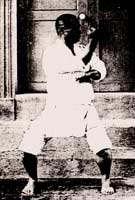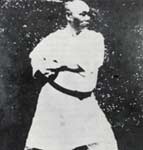glad2bhere
Master Black Belt
I don't know if this will help but that last comment sent me running for a copy of OKINAWAN KEMPO by Choki Motobu. Originally published in May of 1926 the copy I have is copyrighted by Seiyu Oyata in 1977.
In this particular book Motobu states that "There have been numerous styles in Karate..... among those styles (kata) which have been used in Ryukyu from ancient days are {goes on to list names of 12 kata}....... especially the three styles of Naihanchi, Passai (great and small) and KuShanKu are very widely know to islanders........however the Nai-hanchi, Passai, Chinto and Rohai are not left in China today, and remain only in Okinawa as martial arts."
Now the reason I took the time to type this in is because later Motobu comments that "as to Pinan (5 katas) the modern time warrior Mr. Itosu originated this style to use as teaching material for his students."
My sense is that if the Nai-hanchi had been originated in Okinawa by Itosu either in part or in whole, or by Matsumura for that matter, Motobu would have commented something to this effect like he did about the Pinan. As I said before there is still a form supposedly practiced in Taiwan that looks like Naihanchi so I suggest that maybe we are looking at something of an artifact left over from an early time in China and now only remaining in Okinawan practice. For what its worth....
Best Wishes,
Bruce
In this particular book Motobu states that "There have been numerous styles in Karate..... among those styles (kata) which have been used in Ryukyu from ancient days are {goes on to list names of 12 kata}....... especially the three styles of Naihanchi, Passai (great and small) and KuShanKu are very widely know to islanders........however the Nai-hanchi, Passai, Chinto and Rohai are not left in China today, and remain only in Okinawa as martial arts."
Now the reason I took the time to type this in is because later Motobu comments that "as to Pinan (5 katas) the modern time warrior Mr. Itosu originated this style to use as teaching material for his students."
My sense is that if the Nai-hanchi had been originated in Okinawa by Itosu either in part or in whole, or by Matsumura for that matter, Motobu would have commented something to this effect like he did about the Pinan. As I said before there is still a form supposedly practiced in Taiwan that looks like Naihanchi so I suggest that maybe we are looking at something of an artifact left over from an early time in China and now only remaining in Okinawan practice. For what its worth....
Best Wishes,
Bruce


